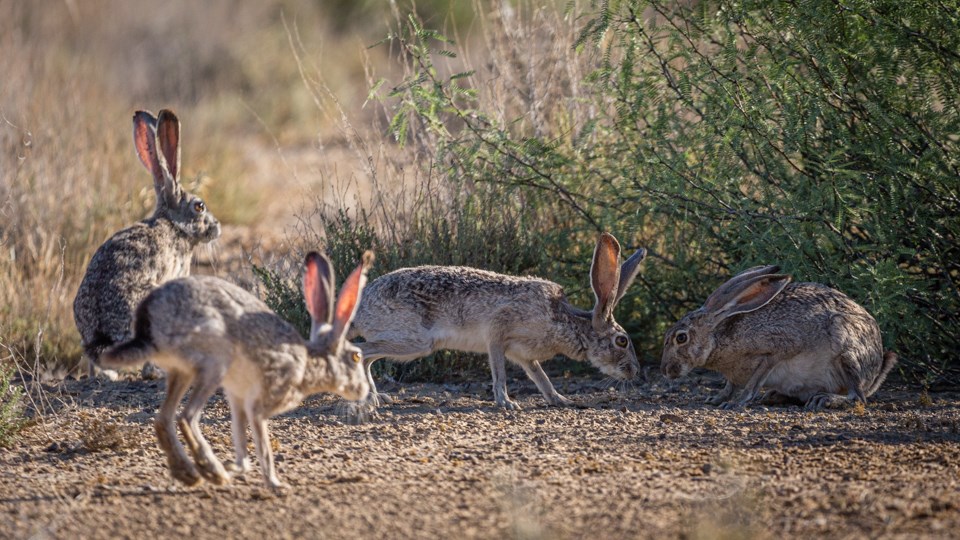
NPS/CA Hoyt 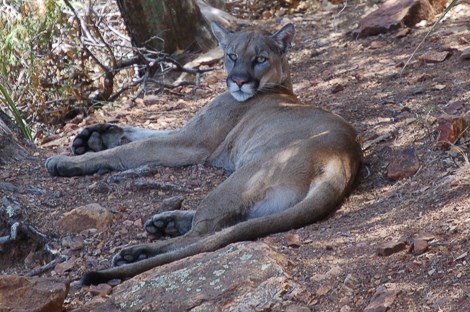
NPS/R. Wonite Mountain LionPuma concolorMountain lion, cougar, puma, panther—all different names for the same animal. This large cat can live in many different habitats, including forested mountains, grassland, and desert. As obligate carnivores, mountain lions eat only meat. Their preferred diet consists mainly of deer, though in the Big Bend region, javelina and rabbits may also be on their menu. As apex predators, mountain lions play an important role in limiting herbivore populations, which helps maintain diverse and sustainable ecosystems. Learn more about what to do if you encounter one in the park. 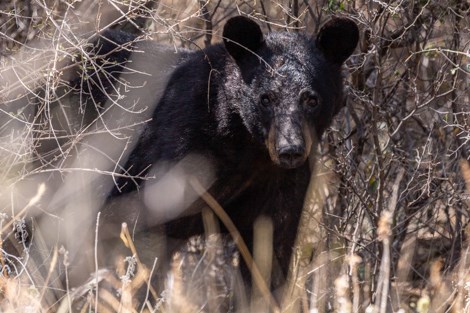
NPS/CA Hoyt Black BearUrsus americanus eremicusIn the early 1900s, black bears were common in the Chisos Mountains in Big Bend country. By the time the national park was established in 1944, there were virtually no resident bears left. Shooting and trapping by ranchers, federal predator control agents, recreational hunters, and loss of habitat contributed to their decline. In the late 1980s an amazing series of events transpired. Visitors began seeing bears in increasing numbers. Today, visitors regularly observe bears throughout the Chisos Mountains. Learn more about what to do if you see a bear, as well as good habits to adopt when recreating in bear country. 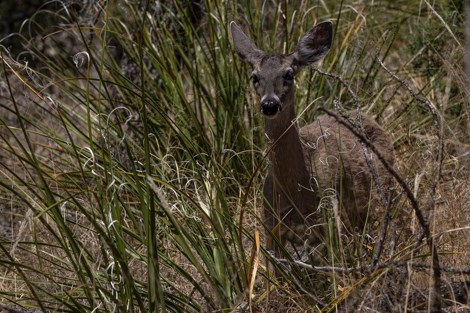
NPS/CA Hoyt DeerBig Bend is home to both mule deer and a subspecies of whitetail deer known as Carmen whitetail. In the United States, Carmen whitetail are only known to occur in Big Bend and a few isolated mountain ranges around the park. Of the 4 subspecies of whitetail found in Texas, the Carmen whitetail is the smallest, with an average weight of 67 pounds. They are generally found above 4,000 feet, in areas with free-standing water and dense vegetation such as oak stands. Mule deer, on the other hand, are found in rougher canyons and open hillsides with less cover.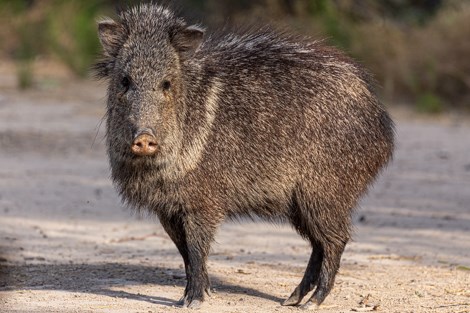
NPS/CA Hoyt Collared PeccaryPecari tajacuCollared peccary, also known as javelina, are found as far south as Argentina and as far north as Texas, New Mexico, and Arizona. Collared peccaries are in the even-toed, hoofed mammal order of Artiodactyla. They usually travel in groups of 2-22 animals; group sizes are larger during the cooler months. Often mistaken for pigs, they are in fact a member of a different family. Click on the picture to find out what makes javelina different from pigs! 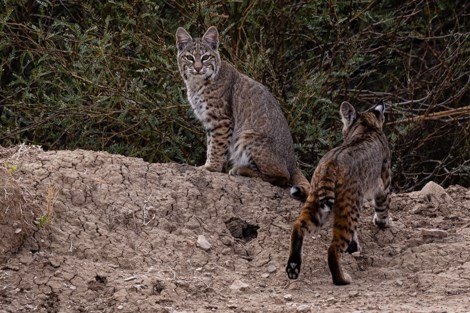
NPS/CA Hoyt BobcatLynx rufusBig Bend's most numerous and commonly seen cat, bobcats live throughout the park, mainly in brushy areas near water. They are normally solitary and not often seen during the day. During some years, they are frequently reported near the Rio Grande Village campground and picnic areas. Bobcats are vital for controlling pest populations, preferring rabbits and hares. However, it will hunt anything from insects, to birds, to small rodents and even deer. 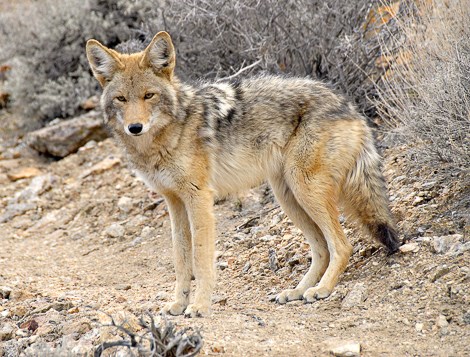
NPS Photo CoyoteCanis latransThe coyote, originally a native of the grasslands, is now found coast to coast in the United States. In addition to the grasslands, coyotes live in deserts, temperate forests, woodlands, swamps, sub-alpine areas, and even in major cities. Despite billions of dollars spent on predator control projects throughout the U.S., coyotes are more abundant than ever. They have survived where other carnivores have not and provide vital population control of rodents and other small mammals. Coyotes fill the void left by the disappearance of the wolf. 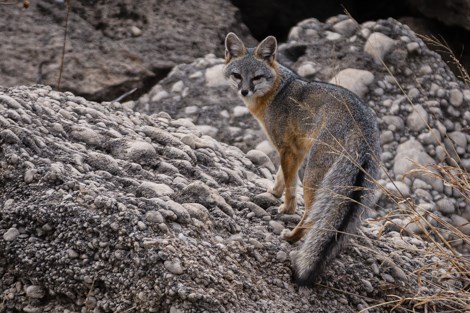
NPS/CA Hoyt Gray FoxUrocyon cinereoargenteusThe most common carnivore in the park, gray fox readily climb cliffs and trees. Their droppings are frequently found on trails and in arroyos. They are occasionally heard making cat-like vocalizations, and are often confused with the rarely seen kit fox. Gray fox are one of only two members of the canine, or dog family, that can climb trees. They will den in trees, underground burrows, or between gaps in rocky places. 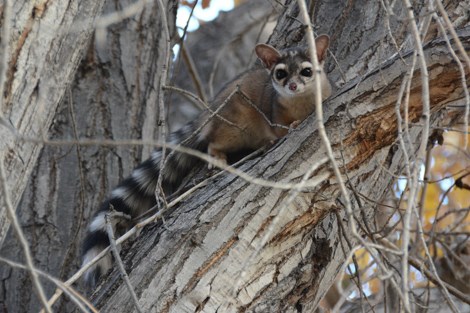
NPS Photo RingtailBassariscus astutusNative to the arid regions of North America, this relative of the raccoon is nocturnal and solitary. However, in regions with adequate water supply, populations of as many as 50 ringtails per square mile may be found. It is said they are easily tamed, even though they are much more timid around humans than raccoons. Miners and settlers once kept ringtails as pets or mousers to help keep their cabins free of vermin. It was this behavior that led to one of their common names, miner's cat. 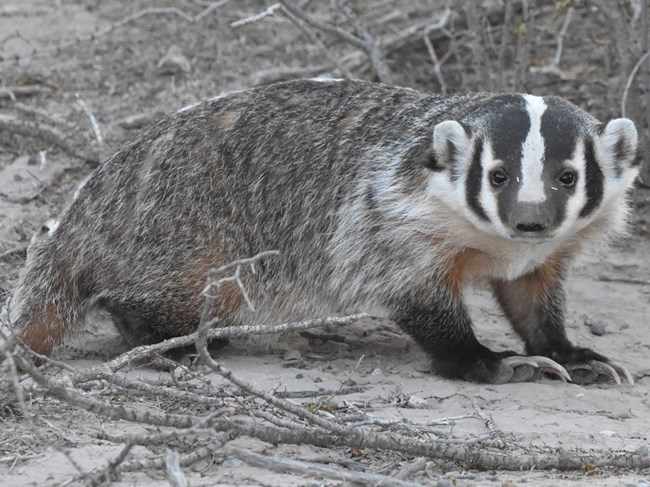
courtesy of K. Lentz BadgerTaxidea taxusBadger habitat is typified by open grasslands with available prey like mice, squirrels and groundhogs. Usually nocturnal, badgers in remote areas with no human encroachment are routinely observed foraging during the day. Interestingly, there is a common misconception that badgers and coyotes hunt together. Badgers are solitary hunters. Coyotes, who are less adept at digging prey out of burrows, are opportunistic hunters and will position themselves near a foraging badger in an attempt to catch prey flushed out by the badger. 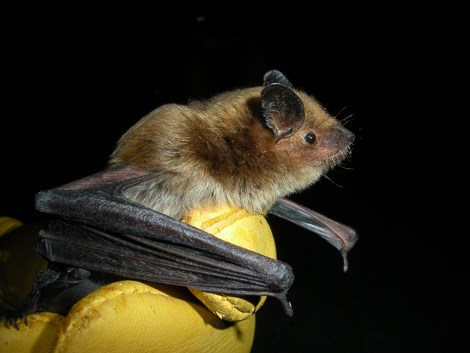
Photo courtesy of K. Demere and L. Ammerman BatsBats make up the largest portion of the park's mammal species; 22 species have been observed here, including the endangered Mexican long-nosed bat. The Mexican long-nosed bat (Leptonycteris nivalis) was first discovered in the United States in a cave in the Chisos Mountains of Big Bend National Park in 1937. Their diet consists of flower pollen and nectar and their migration between the park and Latin America is timed to coincide with the blooming of specific plants, including the century plant (Agave havardiana).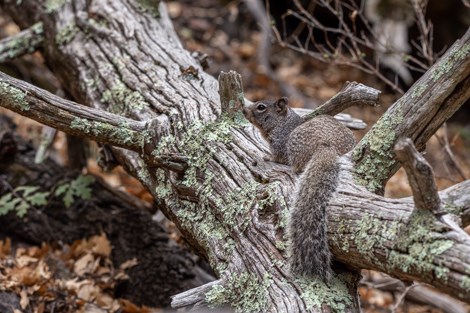
NPS/CA Hoyt Squirrels4 species of squirrels are found in Big Bend. The largest and most common is the rock squirrel, often seen in the higher elevations of the Chisos Mountains. The Texas antelope squirrel is a very secretive, chipmunk-like ground squirrel that occurs throughout the park up to 6,100 feet. It is most commonly seen along the road into the Chisos Basin. The spotted ground squirrel occurs mainly in the lowland desert areas; sometimes seen running across the roadway. The Mexican ground squirrel is considered to be extrememly rare inside the park, but is occasionally seen along the highways north of the park.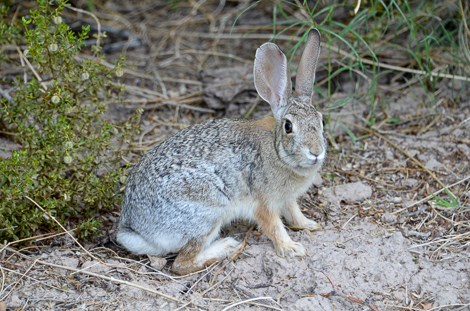
NPS/C. Ballou LagomorphsDid you know that a jackrabbit is not actually a rabbit, but instead belongs to a completely different species known as hares? Rabbits and hares are different from the moment they are born. Baby rabbits are born hairless and blind, while baby hares are born with fur and sight. Rabbits make their homes in underground burrows, hares create nests above ground. Rabbits prefer to eat softer grasses and vegetables, hares like to eat harder bark and twigs. And the most obvious difference? Compare this cottontail rabbit on the left with the jackrabbits in the picture at the top of the page. What physical differences do you see between the two?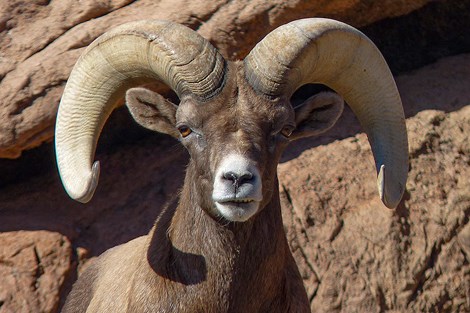
NPS Photo Desert Bighorn SheepOvis canadensis nelsoniDesert bighorn sheep were extirpated from the immediate area prior to park establishment in 1944. The Texas Parks and Wildlife Department has reintroduced this species in the Black Gap Wildlife Management Area to the north and east of the park, leading to a small but persistent population in the northern Deadhorse Mountains area of the park. The white rump and muzzle distinguish the desert bighorn sheep from the invasive aoudad. 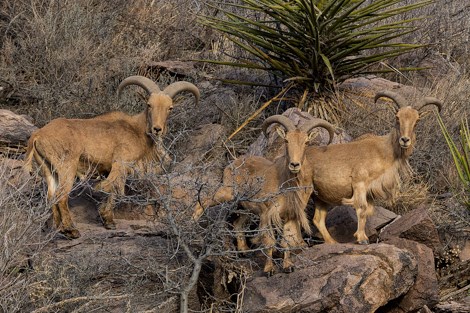
NPS/CA Hoyt AoudadInvasive speciesNumerous exotic barbary sheep (also known as aoudad) which are native to North Africa and the deserts of the Middle East and Asia, now inhabit Big Bend National Park. Founding animals were stocked on private game ranches in Texas, and reproduction and expansion allowed them to invade the park. They have likely been present since the 1970's and now occur parkwide. Aoudad compete with native desert bighorn sheep, and threaten the restoration effort to bring previously extirpated bighorn sheep back to their native land. 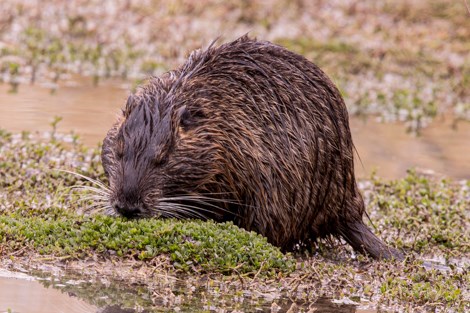
NPS/CA Hoyt NutriaMyocastor coypusInvasive species Nutria first appeared in Rio Grande Village, (the location of this picture) in about 1993. By the late 1990's nutria occupied the entire Rio Grande corridor within Big Bend National Park and the Rio Grande Wild and Scenic River. A flood in 2008 very nearly eradicated them. They were not seen again in the Rio Grande Village area until about 2016. 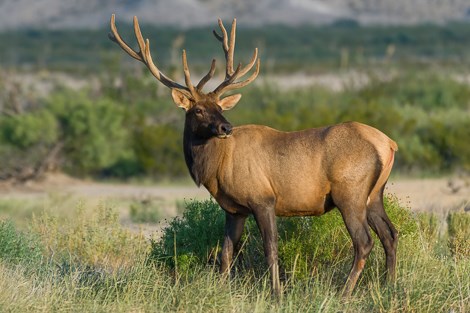
Photo courtesy of S. Aicinena ElkCervus elaphusNonnative species There has been a breeding population in the northern grasslands part of the park since the 1990s. The current population in the park is estimated to be between 30-40 individuals. For many years elk were only seen in the northern part of the park, but recent sightings as far south as Sam Nail Ranch suggest their range within the park is increasing. |
Last updated: June 26, 2022
